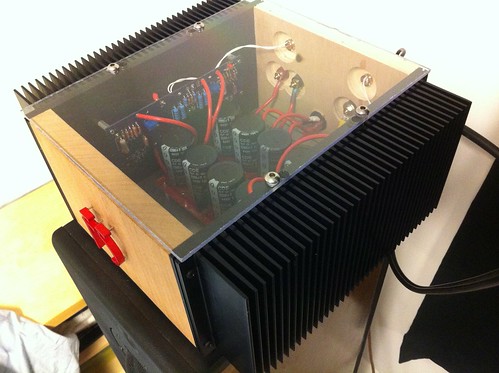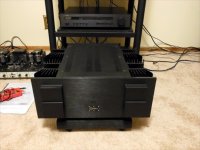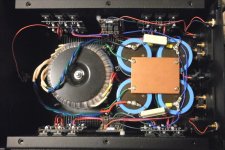A bit off topic...
What are folks experieinces with making cases for Pass designs out of wood? I've seen a few photos in these pages, so I know people are trying this.
My questions are more about long term durability and safety:
I was considering Bubinga or Macassar Ebony for the front and back, and heatsinks on the sides. I hadn't come to a conclusion on the top and the bottom.
What are folks experieinces with making cases for Pass designs out of wood? I've seen a few photos in these pages, so I know people are trying this.
My questions are more about long term durability and safety:
- Does wood dry out over time from heat exposure?
- Does the wood act as an insulator, raising the temperature of the amp?
- Over years, is there a fire hazard?
I was considering Bubinga or Macassar Ebony for the front and back, and heatsinks on the sides. I hadn't come to a conclusion on the top and the bottom.
1. Well seasoned wood should be dry to start with - so no it won't dry out.
2. Not significantly. Yes an alluminium panel will absorb a bit of heat on one side and radiate it on the other, but nothing compared to the heatsinks.
3. Wood requires one of two condtions to ignite. 1) A flame - this could occur if something was arcing but the arcing should surely be supressed by the fuses protecting the amp. 2) A considerable amount of heat - I'm talking about 300 Degrees C. Most electronic components would have given up long before that temperature was reached. - So no it wont be a fire hazard.
If a hot running resistor is touching wood then you might see some blackening but it wouldn't catch fire. It might if it was in an oxygen tent.
2. Not significantly. Yes an alluminium panel will absorb a bit of heat on one side and radiate it on the other, but nothing compared to the heatsinks.
3. Wood requires one of two condtions to ignite. 1) A flame - this could occur if something was arcing but the arcing should surely be supressed by the fuses protecting the amp. 2) A considerable amount of heat - I'm talking about 300 Degrees C. Most electronic components would have given up long before that temperature was reached. - So no it wont be a fire hazard.
If a hot running resistor is touching wood then you might see some blackening but it wouldn't catch fire. It might if it was in an oxygen tent.
1. Well seasoned wood should be dry to start with - so no it won't dry out.
2. Not significantly. Yes an alluminium panel will absorb a bit of heat on one side and radiate it on the other, but nothing compared to the heatsinks.
3. Wood requires one of two condtions to ignite. 1) A flame - this could occur if something was arcing but the arcing should surely be supressed by the fuses protecting the amp. 2) A considerable amount of heat - I'm talking about 300 Degrees C. Most electronic components would have given up long before that temperature was reached. - So no it wont be a fire hazard.
Thanks.
I don't have easy access to metal cutting tools, but I can handle wood. Making Pass amp enclosures is a lot easier in wood than aluminum or copper.
Oneplustwo,
I followed your build thread. Glad you got it working.... Looks super. You must be proud of the result after the work you put in
Wood cases seem fine for amps, but maybe not projects that need the shielding of a metal chassis.
Evan
I followed your build thread. Glad you got it working.... Looks super. You must be proud of the result after the work you put in
Wood cases seem fine for amps, but maybe not projects that need the shielding of a metal chassis.
Evan
Wood dried in the open air eventually comes to ~20% moisture content.
Brought indoors to a heated and drier atmosphere, it will dry out even more, usually towards 10% moisture content.
Wood laid on a heated floor dries to ~6% moisture content. I would expect wood around an amplifier to come to a similar figure.
So the answer is very much a yes. From ~20% to ~6%.
Fire hazard: no. Source of fuel: yes.
Insulator: yes !!!!!! This needs a lot of design input to ensure the amplifier can work in the operating temperatures you will impose.
Brought indoors to a heated and drier atmosphere, it will dry out even more, usually towards 10% moisture content.
Wood laid on a heated floor dries to ~6% moisture content. I would expect wood around an amplifier to come to a similar figure.
So the answer is very much a yes. From ~20% to ~6%.
Fire hazard: no. Source of fuel: yes.
Insulator: yes !!!!!! This needs a lot of design input to ensure the amplifier can work in the operating temperatures you will impose.
Last edited:
I would put some LARGE holes above and below the caps to help them keep cooler. It will still get very warm inside an unventilated case.
I even ended up fitting two 50mm fans above mine, all-be-it only running at half voltage to keep them quiet.
I even ended up fitting two 50mm fans above mine, all-be-it only running at half voltage to keep them quiet.
Wood dried in the open air eventually comes to ~20% moisture content.
Brought indoors to a heated and drier atmosphere, it will dry out even more, usually towards 10% moisture content.
Wood laid on a heated floor dries to ~6% moisture content. I would expect wood around an amplifier to come to a similar figure.
So the answer is very much a yes. From ~20% to ~6%.
Fire hazard: no. Source of fuel: yes.
Insulator: yes !!!!!! This needs a lot of design input to ensure the amplifier can work in the operating temperatures you will impose.
True, but in his context it's quite safe to use.
You can always line the inside with metal foil.
Just think how many valve radios and TV sets have been manufactured with a wood frame.
Check out John's artwork in wood : http://www.diyaudio.com/forums/atta...5-1000-watt-sub-amp-design-build-im001616.jpg
Just think how many valve radios and TV sets have been manufactured with a wood frame.
Check out John's artwork in wood : http://www.diyaudio.com/forums/atta...5-1000-watt-sub-amp-design-build-im001616.jpg
Replace those awful Tantalums next to the input MOS-FETs and you will hear a MASSIVE improvement. We used ELNA Silmic II. The Tantalums gave the amp an awful sibilance.
Last edited:
Who is this John.
MJL21193, John's a pro carpenter something.
http://www.diyaudio.com/forums/solid-state/119958-1000-watt-sub-amp-design-build.html
Replace those awful Tantalums next to the input MOS-FETs and you will hear a MASSIVE improvement. We used ELNA Silmic II. The Tantalums gave the amp an awful sibilance.
If you read through my Brother-in-Laws original thread you can see some of the lessons that he learned.
http://www.diyaudio.com/forums/pass-labs/172276-aleph-4-strickly-diy-project-build.html
I can see remarkable similarities in the two projects.
Replace those awful Tantalums next to the input MOS-FETs and you will hear a MASSIVE improvement. We used ELNA Silmic II. The Tantalums gave the amp an awful sibilance.
I will try your solution😉
But because Mr. Pass uses tantalum in the aleph series?🙄
my amp sounds great so it does not have any problem.😛
I have found that wood can act as a resonator and amplify any mechanical noise emitted from a transformer. That being said, it doesn't stop me.
Didn't build it. Had Tim Rawson make it. The original transformer by Krell failed and was irreplaceable. It's an Aleph 2 clone with all Pass Labs boards. I fashioned the bus plate from 1/4 inch copper just because it looked cool. The fins are almost adequate. In warmer months it can start getting too hot, so it's my winter amp.
Attachments
Last edited:
The fins are almost adequate.
Mr Rawson must be a pretty smart guy.
Personally, i don't quite see how to get 2 times 300W dissipation from a KSA150 chassis, that was designed to handle 300W total at idle, aka 75W per heatsink.
(e.g., the official Krell brochure of the MDA300 model states 400W dissipation from 6 of the exact same heatsinks, same chassis as the KSA250, aka 67W per heatsink)
At least the front end boards have Mr Rawson written all over them.
Last edited:
I will try your solution😉
But because Mr. Pass uses tantalum in the aleph series?🙄
my amp sounds great so it does not have any problem.😛
Mine might have had rubbish tants in it but the ELNA Silmic IIs made a HUGE HUGE difference.
I don't know about suppliers in Italy but here is a supplier in the UK. http://www.hificollective.co.uk/components/elna_capacitors.html
If you cant get them let me know, they should post out to Italy though.
Last edited:
Evanc - Sorry for missing this earlier. Thanks for following the thread. I had fun building it. Especially given all of the casework was scraps or repurposed parts (except for the heat sinks of course.) Even the amp board kit from techdiy was at a discount since he was nice enough to refund my money since the kits were not correct. This is probably the cheapest F5 ever built!
The F5 is so simple, especially compared to the Beta24 I'm currently trouble shooting. And of course, it sounds great.
Relative to using wood in amps, I've had good luck with them in the past and now with my F5. This is probably my 5th project with wood pieces integrated to some degree. Also, I personally like the contrast in material choices.
The F5 is so simple, especially compared to the Beta24 I'm currently trouble shooting. And of course, it sounds great.
Relative to using wood in amps, I've had good luck with them in the past and now with my F5. This is probably my 5th project with wood pieces integrated to some degree. Also, I personally like the contrast in material choices.
Oneplustwo,
I followed your build thread. Glad you got it working.... Looks super. You must be proud of the result after the work you put in
Wood cases seem fine for amps, but maybe not projects that need the shielding of a metal chassis.
Evan
Pass DIY Addict
Joined 2000
Paid Member
Wooden chassis
Here is my wooden chassis a40. Its been up and running for about 10 years and for the past 3 years it has been running 7 hours per day, 5 days per week with no trouble. I made it from a cut-down bed rail that I purchased for $3...
More pictures/details available in signature links.
Here is my wooden chassis a40. Its been up and running for about 10 years and for the past 3 years it has been running 7 hours per day, 5 days per week with no trouble. I made it from a cut-down bed rail that I purchased for $3...
An externally hosted image should be here but it was not working when we last tested it.
More pictures/details available in signature links.
- Home
- Amplifiers
- Pass Labs
- Pictures of your diy Pass amplifier


